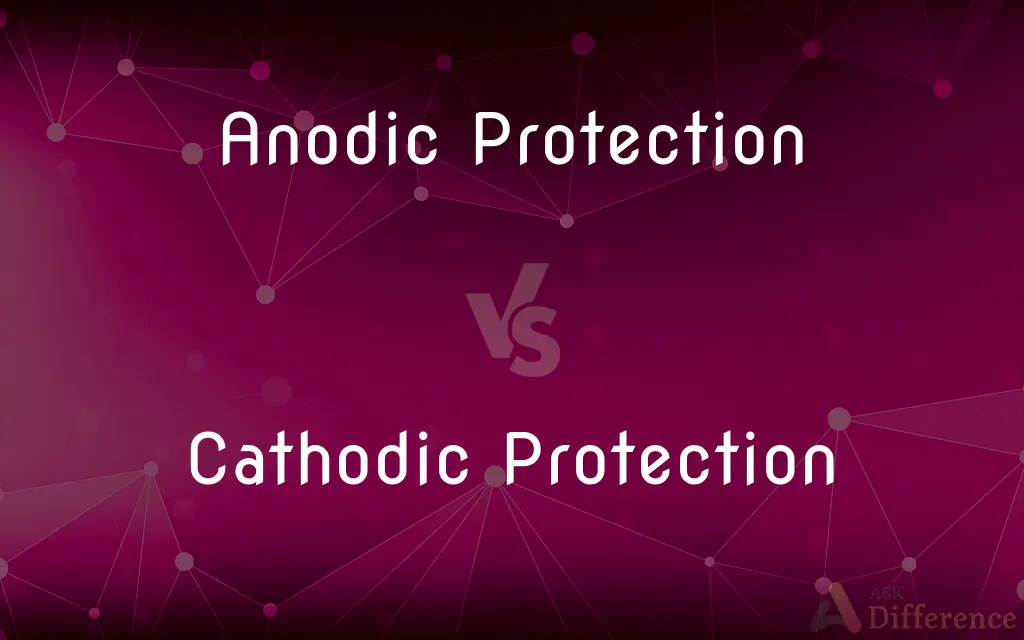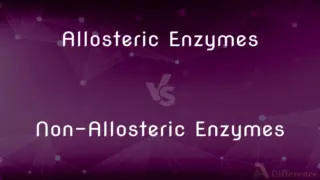Anodic Protection vs. Cathodic Protection — What's the Difference?
By Tayyaba Rehman & Fiza Rafique — Published on February 17, 2024
Anodic protection reduces corrosion by making the metal anode in a corrosive environment, while cathodic protection makes the metal a cathode, preventing corrosion.

Difference Between Anodic Protection and Cathodic Protection
Table of Contents
ADVERTISEMENT
Key Differences
Anodic protection and cathodic protection are two methods used to prevent corrosion in metals, but they operate through fundamentally different mechanisms. Anodic protection involves applying a protective oxide layer to the metal surface, which acts as a barrier to corrosion. This method is typically used in environments where the metal can be passivated, such as in certain acids. Cathodic protection, on the other hand, prevents corrosion by converting the protected metal into the cathode of an electrochemical cell. This is achieved either by attaching a more easily corroded "sacrificial anode" to the metal or by applying an external electrical current, making the metal surface resistant to corrosion.
While anodic protection is effective in controlling the corrosion of metals in highly corrosive environments, it requires careful control of the electrochemical conditions to maintain the passivity of the metal surface. This often involves the use of potent anodic currents and continuous monitoring to ensure that the protective conditions are sustained. Conversely, cathodic protection is more widely applicable, especially for protecting buried or submerged structures like pipelines and ship hulls. It is less dependent on the specific chemical environment and does not require the metal to be passivable.
Anodic protection is less commonly used than cathodic protection due to its complexity and the specific conditions required for its effectiveness. It is mainly applied in industries where corrosive media are handled, such as in the storage of sulfuric acid or in some food processing applications. Cathodic protection, however, is more versatile and can be used in a broad range of environments, including soil, water, and other electrolytes where metals are prone to corrosion.
The choice between anodic protection and cathodic protection depends on various factors, including the type of metal, the corrosive environment, and the practicality of maintaining the system. Anodic protection might be chosen for its ability to protect metals that can form a stable, passive oxide layer, whereas cathodic protection is preferred for its broader applicability and easier maintenance, particularly in cases where passive protection is not feasible.
Both anodic and cathodic protection play crucial roles in extending the life of metal structures exposed to corrosive environments. By understanding the principles and applications of each method, engineers can select the most appropriate corrosion protection strategy for a given situation, ensuring the durability and integrity of metal components and structures.
ADVERTISEMENT
Comparison Chart
Mechanism
Makes the metal an anode, passivating its surface
Makes the metal a cathode, preventing corrosion
Application Environments
Effective in specific corrosive environments
Broadly applicable in various environments
Maintenance and Monitoring
Requires continuous monitoring and control
Requires periodic checks, simpler maintenance
Protective Method
Relies on forming a stable oxide layer
Employs sacrificial anodes or impressed current
Suitability
Suitable for metals that can be easily passivated
Suitable for a wide range of metals and environments
Compare with Definitions
Anodic Protection
A method to control metal corrosion by passivation.
Anodic protection is used in sulfuric acid tanks to prevent corrosion.
Cathodic Protection
A technique to prevent corrosion by making metal the cathode.
Cathodic protection is widely used to protect pipelines from rusting.
Anodic Protection
Requires careful electrochemical condition monitoring.
Regular monitoring is essential for maintaining anodic protection effectiveness.
Cathodic Protection
Minimizes the electrochemical reactions causing corrosion.
Cathodic protection prevents the chemical process that leads to corrosion.
Anodic Protection
Involves applying an electrical current to form a protective layer.
Through anodic protection, a stable oxide layer is formed on the steel surface.
Cathodic Protection
Can use sacrificial anodes or impressed current systems.
Sacrificial anodes provide cathodic protection to ships.
Anodic Protection
Aims to maintain metal in its passive state.
Anodic protection keeps the metal surface in a state that resists corrosion.
Cathodic Protection
Requires less intensive monitoring than anodic protection.
Cathodic protection systems are checked periodically for their anode consumption.
Anodic Protection
Primarily used for metals in highly corrosive environments.
Stainless steel vessels often employ anodic protection in chemical processing.
Cathodic Protection
Effective for buried or submerged metal structures.
Underground storage tanks are often safeguarded with cathodic protection.
Common Curiosities
How does cathodic protection work?
It prevents corrosion by making the protected metal the cathode of an electrochemical cell.
Where is anodic protection most commonly used?
In industries handling corrosive fluids, like sulfuric acid storage.
What is anodic protection?
It's a corrosion prevention method that uses electrical current to form a protective oxide layer on a metal.
Is cathodic protection suitable for offshore structures?
Yes, it's widely used for offshore platforms and ship hulls.
What does anodic protection require to be effective?
Continuous monitoring and control of the electrochemical conditions.
What makes cathodic protection versatile?
Its applicability in a wide range of environments and simpler maintenance requirements.
How do environmental conditions affect cathodic protection?
Environmental conditions determine the type and size of the protection system needed.
What are the key components of cathodic protection?
Sacrificial anodes or impressed current systems.
How often should cathodic protection systems be checked?
Periodically, to assess the condition of sacrificial anodes and power sources.
Can cathodic protection systems be automated?
Yes, modern systems can be automated for monitoring and control.
Can anodic protection be used on all metals?
No, it's suitable for metals that can form a stable, passive layer.
Can anodic protection be applied to underground structures?
Rarely, as it's more suited to controlled environments.
What are the limitations of anodic protection?
It's limited to specific environments and requires precise control.
Does anodic protection use sacrificial anodes?
No, it relies on applying an external current for passivation.
How does the choice between anodic and cathodic protection depend on cost?
The decision can be influenced by installation, maintenance costs, and the specific protection needs of the structure.
Share Your Discovery

Previous Comparison
Squalane vs. Hemi-Squalane
Next Comparison
Allosteric Enzymes vs. Non-Allosteric EnzymesAuthor Spotlight
Written by
Tayyaba RehmanTayyaba Rehman is a distinguished writer, currently serving as a primary contributor to askdifference.com. As a researcher in semantics and etymology, Tayyaba's passion for the complexity of languages and their distinctions has found a perfect home on the platform. Tayyaba delves into the intricacies of language, distinguishing between commonly confused words and phrases, thereby providing clarity for readers worldwide.
Co-written by
Fiza RafiqueFiza Rafique is a skilled content writer at AskDifference.com, where she meticulously refines and enhances written pieces. Drawing from her vast editorial expertise, Fiza ensures clarity, accuracy, and precision in every article. Passionate about language, she continually seeks to elevate the quality of content for readers worldwide.
















































